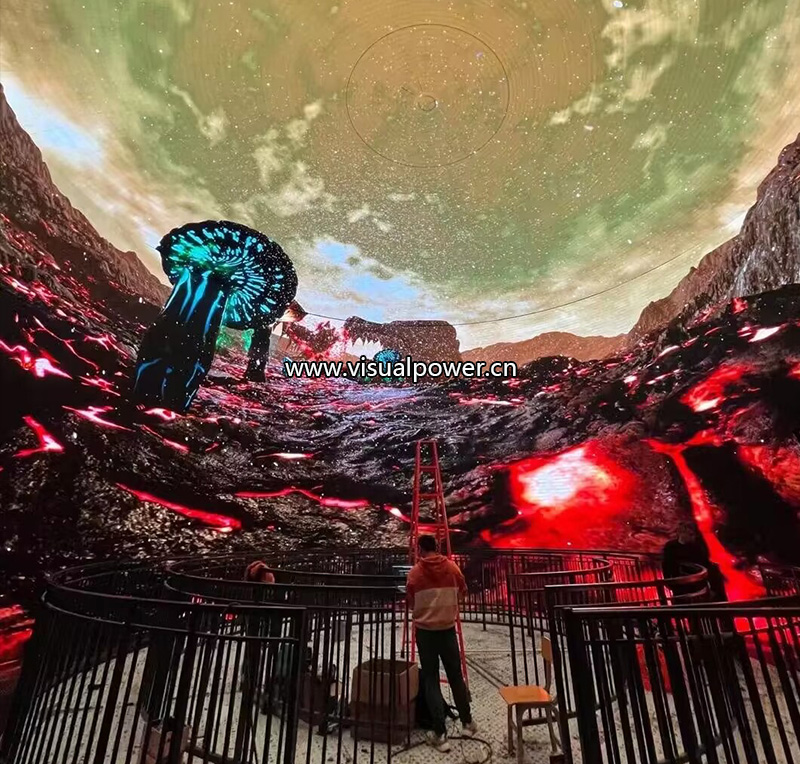Kategorien
- News (60)
- Fallstudie (6)
I have always believed that technology itself is not captivating; what truly touches people’s hearts is the experience hidden behind it. This is also why, after seeing so many screens, I still get excited because of an Immersive LED display. It’s not a cold stack of hardware, aber a “portal” that can kick you into another world with one foot.
The first scene that truly struck me with the word “immersive” was not the metaverse or VR, but a concert. The edge of the stage, the ground and the top of the head were all surrounded by LED lights, and the audience seats seemed to be trapped in an entire flowing universe. In diesem Moment, I thought: This is not just watching, but being swallowed up.

Some people understand Immersive LED as “getting bigger and brighter”, but I’m increasingly aware that its essence is the elimination of boundaries. Traditional display is “the audience outside, the content inside”, while the essence of immersion lies in “you are within the content”.
An immersive exhibition project I participated in laid LED screens on the ceiling, floor and even the corners of the corridor. You must pass through the channels formed by the screens before entering the next section of space. This sense of “participation” cannot be measured by technical indicators; it is more like a psychological entry.
Another time, we created a virtual forest-themed experience hall, with screens laid out in front, zurück, left and right, complemented by spatial sound effects and fragrance diffusion. Standing right in the middle, for a moment I really couldn’t tell the boundary between reality and content. One second you are still standing on the concrete ground, and the next second it seems as if there is the rustling sound of fallen leaves at your feet.
Die Schwierigkeit dieser Art von Bildschirm war noch nie in der Hardware, aber in – Welche Art von Geschichte wirst du erzählen?
LED -Bildschirme können vollständig umgeben, Aber wenn der Inhalt nicht gut gemacht ist, Es wäre, als würde man einen 80-Zoll-Fernseher zusammensetzen 360 Grad, das würde auch keine Menschen bewegen. Beim Eintauchinhalt geht es nicht um Spleißen, sondern um das Spleißen “fließen”.
Normalerweise fange ich eher von einem emotionalen Punkt als dem Bild an. Zum Beispiel, Wenn Sie das Gefühl von schaffen möchten “in einen Traum fallen”, Das Bild kann nicht zu springen sein. Eine Atmosphäre von schaffen “Der Aufstieg der Technologie”, Jeder Übergang sollte wie der Rhythmus einer Maschine sein, die beginnt. Dieser Rhythmus ist die einzigartige Sprache, die die immersive LED mit dem Raum ausgeben kann.
Ich habe auch eine Erfahrung gelernt: Leere Platz zu lassen ist sehr wichtig. Nicht alle Räume müssen mit Bildern gefüllt werden. Manchmal, Das Verdunkeln einer Wand kann tatsächlich einen emotionalen Kontrast erzeugen. Der visuelle Höhepunkt ist oft nicht der schillerndste Sekunde, Aber der Moment, in dem Sie gerade aus der Dunkelheit auftauchen.
When it comes to technology, I have to mention a few pitfalls that I have personally tested and found “not to be ignored”.
The first one is the joint gap. Immersive LED is most afraid of “perforation”. Even a 0.5mm seam can ruin the sense of spatial continuity. So every time I ask the on-site installation team to confirm with both the naked eye and the camera.
The second is perspective consistency. You can never imagine how a “blind spot” can ruin the experience. Once in a science fiction-themed pavilion, we spliced 270-degree leds in a corner. Jedoch, when the audience stood right in the middle, there was one area with a color that was obviously too cold, directly spoiling the “immersion”. It was later discovered that the color calibration logic of the control system was not uniform.
Thirdly, the sound effect system should be designed collaboratively. Don’t think that LED has nothing to do with speakers. The immersive “envelopment” effect is achieved through the combined efforts of vision and hearing. I’ve seen too many projects where the LED is made to perfection, but the background sound is like a radio, completely out of place.
I have always believed that the greatest value of Immersive LED display is not to amaze people, but to remember people.
Remember a scent, a piece of music, or an image that flashes through a visual vortex. These memories exist not because of what we have seen, but because we have “entered” once.
In my mind, those immersive LED Spaces are not merely screens for displaying content; they are more like a new type of “spatial narrative”. It requires you to re-understand the stage, the exhibition and the public space. It turns viewing into a journey rather than a stay.
You can temporarily forget its resolution, refresh rate and module size, but you won’t forget those few minutes when you were taken to another world by it.